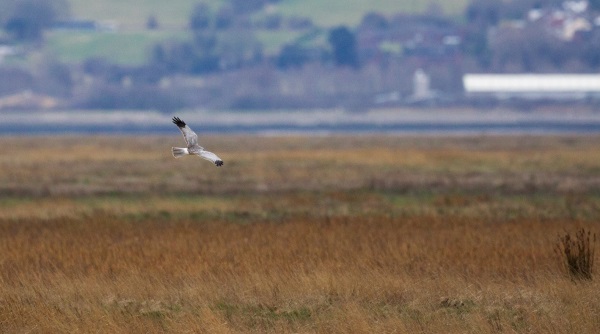Site menu:
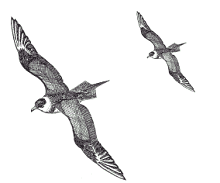
August 2015 Newsletter
Wetland Bird Survey 2013/14.
Colour Ring Report.
Liverpool Bay SPA.
Hen Harrier Day.
July Bird News.
Forthcoming Events.
Latest Newsletter.
Wetland Bird Survey 2013/14

Both the National and local (Dee
Estuary) Wetland Bird survey (WeBS) reports for the period July 2013 to
June 2014 have recently been published. As always this gives us an
opportunity to look at trends and numbers and it enables us to evaluate
how 'our' birds are doing in comparison to the national picture. It has
to be said that the winter of 2013/14 wasn't good for bird numbers on
the Dee Estuary with wildfowl counts particularly low, even Canada
Geese were down! It's not all doom and gloom, however, as Pink-footed
Geese numbers are still very high with max of 3,320, and although Teal
and Wigeon numbers were down compared to 2012/13 they were both still
bang on the five year average. Wader counts were a bit mixed, for
example over-wintering Ringed Plovers were very low but passage numbers
were the highest for over 40 years.
The reasons for low counts for many species, which in many cases is reflected nationally, is no doubt complex but a major cause will have been the mild weather and I quote the national report "The 2013/14 winter proved to be very mild, with no prolonged spells of cold weather. Virtually all months were warmer than average, while storms in January-February 2014 delivered gales with inland and coastal flooding". Mild weather, of course, means that many birds short-stop on the continent with no reason to make the journey across the North Sea.
Below I go into a bit more detail for
three species, all of which did well in 2013/14. It is noteable that
these all breed in Iceland and/or the UK so short-stopping on the
continent isn't an issue.
Cormorant
There was a record WeBS count of 1,633 in November 2013. Numbers have increased steadily from the 1980s when they were around the 150 to 200 mark, to 1,457 in 2007/08 since when they had decreased to 1,186 by 2012/13 before the recent record count. The Dee Estuary is the second most important site for this species in the UK, both for 2013/14 and for the five year average which is now of International Importance. Nearby Ribble Estuary is the most important UK site due to three very high counts for 2011/12, 2012/13 and 2013/14 including 3,297 in December 2012. Just across the Mersey channel on the Alt Estuary and Formby shore there was a count of 1,489 in October 2013, making it the third most important site that year. All these birds will be part of the same Liverpool Bay over-wintering population, sometimes these birds can form huge roosts and a massive 3,884 were counted flying out of the Dee Estuary at first light on January 20th 2015 after spending the night off Parkgate - it is believed this is the highest ever single count of this species in the UK. For more details of Cormorants on the Dee Estuary see Species Spotlight - Cormorant.
Oystercatcher
The max count was 28,715 in November 2013 with another high count, of 28,296, in January 2014 which are the highest Dee estuary WeBS counts since 34,610 were counted in December 1992. Numbers plummeted through the 1990s due to unregulated industrial scale cockling. In 2008 the Cockling Regulating Order came into force and it has made a huge difference to the sustainability of the fishery, the amount of cockles available for the birds, the amount of damage to the mud flats and the amount of disturbance - all of which have improved. Presumably the current increase in numbers is because of it.
This increase on the Dee estuary is not reflected nationally where there has been a slow but steady drop over the past 20 years, but with a big fall in 2013/14. The north-west of England is a very important area for this species with Morecambe Bay the most important site (five year average of 53,979), the Dee estuary second (five year average 25,775) and the Solway estuary the third most important (five year average 23,942). There was a massive count of 82,288 Oystercatchers in Morecambe Bay in September 2010 which I'm pretty sure is the highest ever UK count. These birds obviously move around with peak counts on Morecambe Bay and on the Solway nearly always in autumn whereas those on the Dee estuary are in winter.
Black-tailed Godwit
There was a record Dee estuary WeBS count of 6,484 in November 2013, the previous highest being 6,274 in November 2010. In the mid-1980s numbers were around the 500 mark since when they climbed steadily to just over 5,000 10 years ago since when max numbers have fluctuated somewhat reaching as low as 3,713 in September 2006.
Nationally numbers show a similar pattern with a steady increase from 1980 to 2004/05 since when they plateaued out. But 2012/13 saw a big increase with similar numbers in 2013/14. In 2013/14 the Dee estuary was the second most important site with the Wash the most important with a count of 7,540. However, it is the Thames estuary which holds the record for the highest ever count with 12,740 in January 2013. The Ribble estuary is also very important for this species with sometimes thousands on the Marshside RSPB reserve near Southport, max WeBS count for 2013/14 there was 5,213 in January 2014. Colour ringing shows there is much movement between the Dee estuary and Marshside, and indeed with other sites such as the Mersey estuary and Leighton Moss RSPB on Morecambe Bay.
The recent national increase in 2012/13 and 2013/14 could well be due to birds of this Icelandic race short-stopping in this country during mild winters, rather than flying further south to France, Spain and Portugal. This makes a nice change from the many species which short-stop on the continent rather than flying here across the North Sea!
References:
1. On-line WeBS Report 2013/14 - http://www.bto.org/volunteer-surveys/webs
2. Colin Wells and Neil Friswell, Dee Estuary and North Wirral Foreshore WeBS Annual Report 2013/2014.Richard Smith
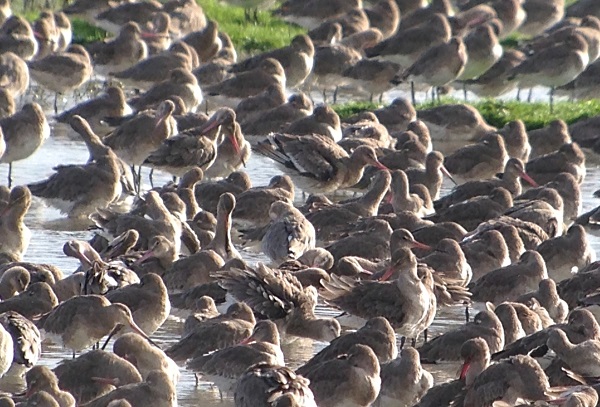
Colour Ring Report
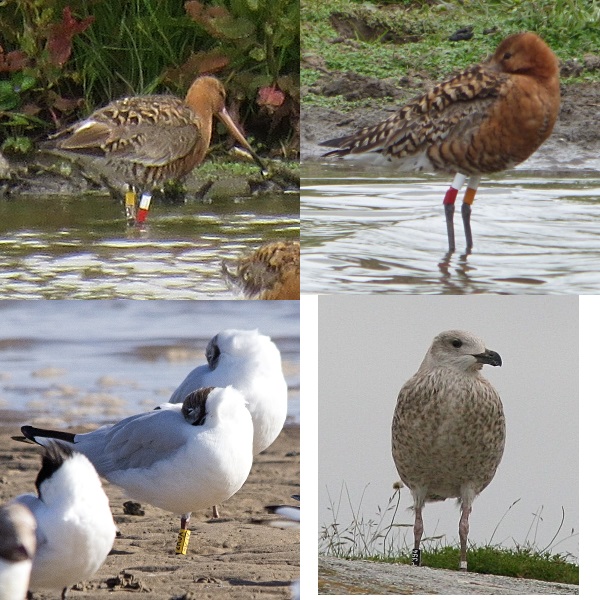
Black-tailed Godwits
The Godwits started to return from Iceland mid-month and we had logged 10 colour-ringed birds by the end of July, a record for us. Five of these were new to us and we are still waiting feedback for many of these. Below are the details for the two photographed above plus one ringed on the Wash.
Y8-WR ringed as adult in north-west Iceland on July 10th 2012.Recorded at Gilroy Nature Park, West Kirby, on 20th, 25th and 30th July 2015.
Seen in West Sussex in September 2102.
Was in East Scotland, mainly in the Montrose Basin, from July 7th to November 23rd 2013.
July to December 2014 saw it in north-east England.
See 'A Profusion of Y8s' article in the May 2015 newsletter, Y8-WR is the firth bird we've seen from that 2012 catch of 20 birds.
WO-WRflag ringed as a chick in north Iceland on July 13th 2007.
Recorded at Gilroy Nature Park, West Kirby, on July 19th 2015 and on several dates through the rest of the month.
From November 2007 to November 2013 it was recorded 11 times at several sites in Ireland.
July 2012 saw it near Halifax, West Yorkshire, and in September 2012 it was at Marshside RSPB.
First record on the Dee estuary was at Gilroy Nature Park in July 2014 and it remained in the area until November 2014 being seen also on Thurstaston Shore and off Cubbin's Green.
L-OO/W ringed as an adult on The Wash on September 13th 2014.
Recorded at Burton Mere Wetlands on July 14th 2015 then on several dates through the rest of the month at both Gilroy Nature Park, West Kirby, and Thurstaston Shore.
Seen in west Iceland on April 22nd 2015.
Great Black-backed Gulls
JP394 white letters on a black ring.Ringed as a chick near Stavanger, Norway, on June 19th 2013 (photo above taken at same site on July 9th 2013).
Recorded on Hoylake Shore on July 3rd 2015.
Also seen at a landfill site in Leicester & Rutland on three dates between October 2013 and February 2015.
T5ZV yellow letters on a black ring.
Ringed on Kitterland island, Isle of Man, on July 22nd 2013.
Recorded on Hoylake Shore on July 3rd 2015.
Black-headed Gull
2KJX black letters on yellow ring.Ringed at Pitsea Landfill Site, Essex, on March 21st 2015.
Recorded at West Kirby (near the Marine Lake) on July 25th 2015.
Richard Smith and Matt Thomas.
Colour-ringed birds were also recorded by Elliot Monteith, Alan Hitchmough, Chris Butterworth and Steve Hinde.
Top of Page
Liverpool Bay SPA

We have just received notification that there is a proposal to extend Liverpool Bay SPA (Special Protection Area), both in terms of the area covered and the species cited.
This is very good news and it is part of the pressure being put on the Statutory bodies (in England this is Natural England, in Wales it is Natural Resources Wales) to effectively protect birds whilst out to sea - whether they be birds such as terns foraging from nesting colonies or birds spending the winter off shore. I quote from the Natural England document Establishing marine Special Protection Areas "Further work is required to complete a marine UK-wide network of SPAs at sea in order to meet the needs of our breeding and wintering seabirds and our wintering waterbirds".
The map of the area covered by the current SPA and it's proposed extension is shown in the reference below. The extension includes the tidal River Mersey which goes past Liverpool and Birkenhead, an important foraging area for the Common Terns nesting at Seaforth and in the docks. Also now recognised is that the SPA is a vital foraging ground for the Little Tern colony at Gronant and that it also supports the third highest aggregation of Little Gulls in the UK (whilst on migration). In addition Red-breasted Mergansers and Cormorants are now named features of the SPA. Both the Liverpool Bay Common Terns and Cormorants have featured recently in the newsletters in this website, so click on their names to read more about their current status.
Reference : Proposals for an extension
of Liverpool Bay SPA (PDF file):
http://publications.naturalengland.org.uk/file/5473387506827264
Hen Harrier Day
The main attraction of a visit to the Dee Estuary in winter must be the probability of seeing a Hen Harrier flying low over the marshes, a particular thrill if it's an adult male in stunning grey plumage. I know many people travel a long way to see these fantastic birds and we usually get between three and six regularly coming into the roost at Parkgate through the winter.
We don't actually know where the Dee estuary Hen Harriers breed although Wales and the Isle of Man seem likely locations. One thing that does seem certain is that they don't breed in England where they are very close to being completely wiped out by the Grouse Shooting industry, this year alone five breeding males have disappeared in 'mysterious circumstances'.
Hen Harriers have the highest level of legal protection available across the UK and the EU so shooting, trapping and destruction of nests are all highly illegal. In order to celebrate the species and highlight their widespread illegal persecution there is going to be a Hen Harrier Day on Sunday August 9th 2015. The nearest event to the Dee estuary is at Goytsclough Quarry in Derbyshire - see http://henharrierday.org/index.html for details.
One of the speakers at this event is
Mark Avery. A name you might know as he was a very effective
Conservation Director for the RSPB for nearly 13 years. He has just
brought out a book all about the Red Grouse Shooting industry, the harm
it is doing to the ecology of our uplands and in particular the illegal
killing of raptors. It is called 'Inglorious:
Conflict in the Uplands', well worth a read if you want to
find out more about this scandal.
Some more details about Hen Harriers and a nice video can be seen on
the RSPB website -
http://www.rspb.org.uk/discoverandenjoynature/discoverandlearn/skydancer/
LATEST UPDATE (August 5th 2015): Some good news - Natural England have announced that there were a total of 12 Hen Harrier nests in England this year, six of which were successful. There has been an attempt by the shooting industry to smear the conservationists' endeavours to conserve the Hen Harrier - both Natural England and RSPB have robustly defended their efforts.
Read all about it here: http://www.birdguides.com/webzine/article.asp?a=5158 .
Richard Smith
Top of PageJuly Bird News
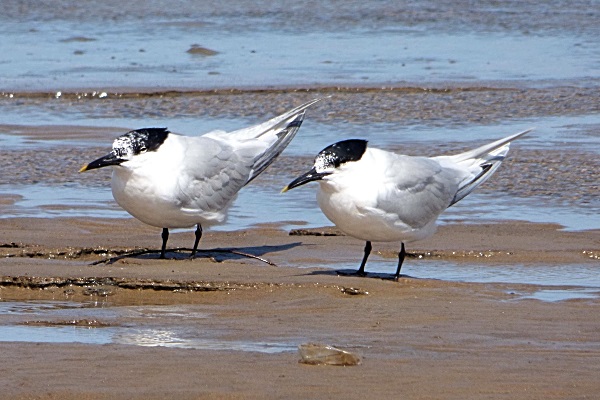
Sandwich Tern numbers steadily built up during the month and there were over 1,000 off Hilbre by the 30th. Dee estuary is one of the most important post-breeding staging sites in the country for this species. It is good to report the continuing recovery of the Shotton Common Tern colony and they produced over 600 chicks this year (494 in 2014) - see 'Liverpool Bay Common Terns'.
The Gronant Little Terns also are having a good season and it looks like they will produce over 100 fledglings, the highest since 2010, but not as many as the wardens had hoped thanks to the attentions of the Kestrels. After my article on Arctic Terns last month it is good to report the presence of several of them off Wirral, with at least three at New Brighton and over six at Red Rocks - and just in case certain people still don't believe that Arctic Terns exist off North Wirral in the summer then I can assure them they were observed at very close quarters and with Common Terns present for comparison, and by very experienced birders.
But the tern of the month was
undoubtedly the Gull-billed Tern at Burton Mere Wetlands on
the 3rd, this is the seventh record for this southern-europe breeding
species in Cheshire and Wirral, the last record being at the same site
in May 2002.
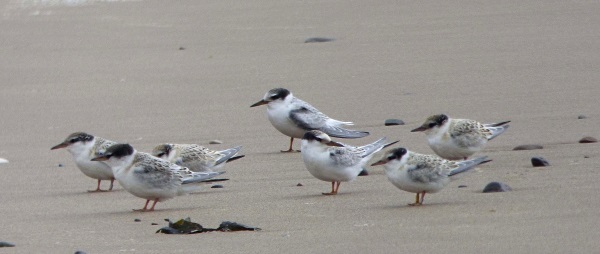
note the two in the middle are several days older than the rest.
Apart from the terns the other delight of birding in July must surely be the return of the waders, particularly those in stunning breeding plumage as shown in the three photographs below. Black-tailed Godwits started returning in mid-month and had reached over 690 at Gilroy Nature Reserve by the 31st. In my latest sightings I've mentioned that this is an Internationally Important count (the threshold is 610), my reason for mentioning this is because it could give this site some measure of protection from the planned Hoylake Golf Resort. More details in next month's Newsletter.
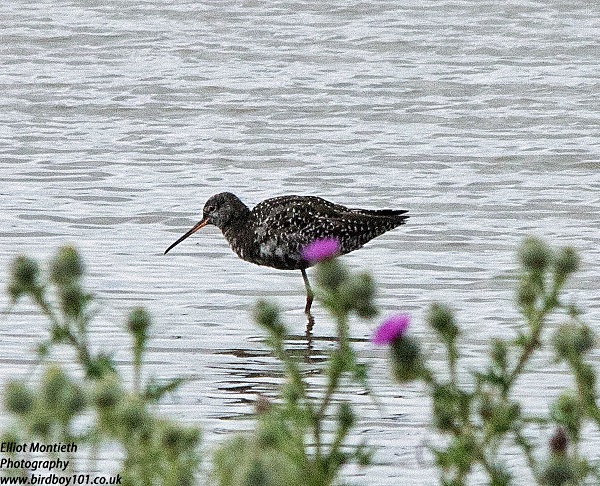
www.birdboy101.co.uk/
Heswall/Thurstaston shore lived up to it's reputation as the best place to see Whimbrels with a max count of at least 80 on a neap high tide on the 26th. This same site is also the best place to see Mediterranean gulls on the Dee Estuary and there were was a max of six on the 11th, with a total of 47 records across the estuary and north Wirral, an excellent total.
For most of the month sea-watching was quiet but we did get some fresh westerlies and there were several records of Arctic Skuas with up to five off Hilbre as well as a Great Skua at Hoylake on the 28th. People are often surprised at the reports of over-summering Common Scoters (obviously non-breeding) and very few people seem to see them apart from me! But they are seen daily, usually flying west, off Gronant and I had a total of 180 there on the 1st. There were many more than the usual number of reports off north Wirral with birds being seen from New Brighton to Hilbre, but I had the highest count with 250 flying west in several flocks off Hoylake on the 28th.
A couple of early Short-eared Owls have been seen with one at Gronant and the other at Parkgate, at the latter site a ringtail Hen Harrier flew by on the last day of the month.
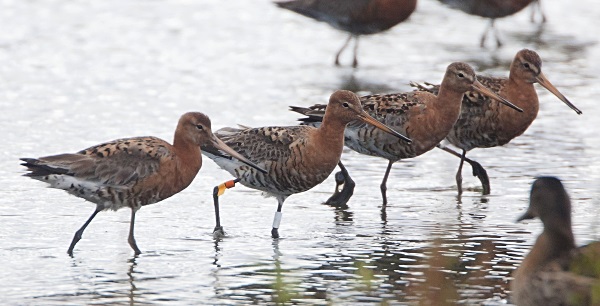
www.fromthemuddybanksofthedee.com/
Richard Smith.
What to expect in August
There will be lots of Terns in the estuary and as Sandwich Terns start to move south the Common Terns will increase, many Little Terns will disperse into the estuary from Gronant as their breeding season finishes - we hope to see plenty of young ones this year. This month is also a good time to see the much rarer Black Tern, one or two can turn up anywhere.
Out to sea strong westerlies could result in large numbers of Manx Shearwaters and a good selection of skuas, and by the end of the month a gale could blow in a few Leach's Petrels. More unexpected out to sea are Goosanders but they are seen regularly flying west or into the estuary in August, usually in flocks of around 10 to 20.
Marsh Harriers will be out on the marsh and one or two are often seen over Burton Mere Wetlands, perhaps with the first returning Hen Harrier; look out for Ospreys overhead but they are much more rarely seen at this time of year than in spring.
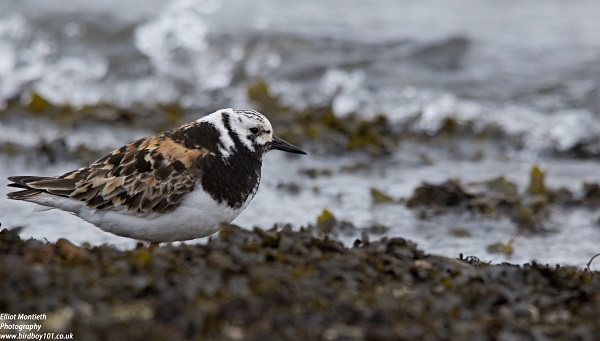
www.birdboy101.co.uk/
Top of Page
Forthcoming Events
August Highest Spring Tides (Liverpool)
Also
see Tides
page.
2nd August, 13.16hrs (BST), 9.6m.
3rd August, 14.01hrs (BST), 9.6m.
30th August, 12.13hrs (BST), 9.7m.
31st August, 12.57hrs (BST), 9.9m.
Forthcoming Events
Organised by the Wirral
Ranger Service , Flintshire
Countryside Service and the
RSPB (Dee Estuary):
All these events and walks have bird interest, even those not
advertised specifically for birdwatching. No need to book for these
events unless specified - please check below.
Also see 2015 Events Diary.
THIS EVENT IS FULLY BOOKED
5.30 pm Saturday to 9 am Sunday
Price: £30 per person (£25 RSPB members); £15 under-14s (£12.50 members)
Back for it's third year, Burton Mere Wetlands' biggest and best family event, is the Big Wild Sleepout 2015.
For one night only, we’re giving families the chance to camp out in the wilderness at one of the best wetlands in the North West.
Join us for exciting evening activities including moth trapping and bat watching, and uncover the secrets of Burton Mere Wetlands' nocturnal wildlife.
Dinner and a light breakfast are provided, and hot and cold drinking water is available on site along with a range of snacks, but bring along any other nibbles and drinks for the evening. Indoor toilet facilities are provided on site.
This fantastic summer sleepout experience will be held overnight on Saturday 8 August. For more information and to book on the event – please call the reserve on 0151 353 8478 or email deeestuary@rspb.org.uk .
Payment in advance is essential.
Saturday 15 August, 9.30 am start, Field Visit to RSPB Burton Mere Wetlands.
This event is run by the RSPB North Cheshire Local Group and is an excellent opportunity to get to know this excellent Reserve in the presence of experts and fellow enthusiasts. Please join us, you don't have to be a member either of the local Group or the RSPB (there is an entrance charge for non-members - £4.00 adults, £2.00 children).
There should be plenty of birds on the reserve including returning migrants and waders.
Don't forget to bring your RSPB membership card if you have one.
Wednesday 26th August, Dusk Spectacl ate RSPB Burton Mere Wetlands.
7 pm start.
Price: Adults £5; RSPB members £4; children half price.
Booking essential - please call the reserve on 0151 353 8478 or email deeestuary@rspb.org.uk
Two of Burton Mere Wetlands' greatest spectacles at this time of year take place as daylight fades, when little egrets fly to roost in the treetops of Marsh Covert and various bats emerge to feed over the pools. This exciting evening walk is your chance to discover the dusk spectacle in all its glory guided by a member of the reserve team.
The Dee Estuary supports the third largest little egret colony in the north of England, and watching them gather into their communal roost is truly amazing. Once the egrets are settled in, attention turns to the bats, with noctules, pipistrelles and Daubenton's the stars of the show, the latter swooping low over the pools to catch insects.
Our bat detectors will enable you to hear the otherwise ultrasonic calls of the bats as they fly inches past our heads - bring your own if you have one. Plus, there's always a chance of catching a glimpse of the reserve's other nocturnal residents.
The trails are fully accessible and the walk less than a mile in total, so the event is suitable for people of all ages and abilities. Price includes a hot drink and snack in the Reception Hide.
Places are limited so book in advance to avoid disappointment.
